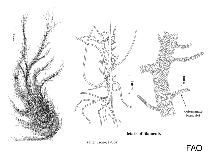Ulva intestinalis Linnaeus
Hollow green nori| Native range | All suitable habitat | Point map | Year 2050 |

|
| This map was computer-generated and has not yet been reviewed. |
| Ulva intestinalis AquaMaps Data sources: GBIF OBIS |
Upload your photos
Google image | No image available for this species;
drawing shows typical species in Ulvaceae.
Google image | No image available for this species;
drawing shows typical species in Ulvaceae.
Classification / Names Common names | Synonyms | CoL | ITIS | WoRMS
Ulvophyceae | Ulvales | Ulvaceae
Environment: milieu / climate zone / depth range / distribution range Ecology
Sessile; depth range 0 - 20 m (Ref. 101733). Subtropical
Distribution Countries | FAO areas | Ecosystems | Occurrences | Introductions
Arctic, Indo-Pacific, Atlantic Ocean, Mediterranean and Black Sea. Subtropical to polar.
Length at first maturity / Size / Weight / Age
Maturity: Lm ? range ? - ? cm Max length : 20.0 cm H male/unsexed; (Ref. 80758)
Short description Morphology
Thalli bright to yellowish green. Several unbranched tubular branches arise from a short stipe; discoid holdfast. Erect branches tapering below, inflated above and constricted or contorted at certain points. Cells polyhedral in surface view, irregularly arranged and filled with spherical to oval chloroplasts.
Grows on rocky substrate in the lower intertidal to shallow subtidal zones or in shallow tidepools exposed to air during low tide (Ref. 80758); also considered as a fresh sea-vegetable (Ref. 82232).
Life cycle and mating behavior Maturity | Reproduction | Spawning | Eggs | Fecundity | Larvae
Main reference
References | Coordinator | Collaborators
Guiry, M.D. and G.M. Guiry. 2009. (Ref. 80701)
IUCN Red List Status (Ref. 130435: Version 2024-1)
CITES status (Ref. 108899)
Not Evaluated
CMS (Ref. 116361)
Not Evaluated
Threat to humans
Harmless (Ref. 80758)
Human uses
Fisheries: commercial; aquaculture: commercial
| FishSource |
Tools
More information
Trophic Ecology
Food items
Diet
Food consumption
Ration
Predators
Diet
Food consumption
Ration
Predators
Ecology
Population dynamics
Life cycle
Reproduction
Maturity
Fecundity
Spawning
Eggs
Egg development
Larvae
Larval dynamics
Maturity
Fecundity
Spawning
Eggs
Egg development
Larvae
Larval dynamics
Distribution
Human Related
Aquaculture profile
Stamps, Coins Misc.
Stamps, Coins Misc.
Outreach
References
Internet sources
BHL | BOLD Systems | CISTI | DiscoverLife | FAO(Publication : search) | Fishipedia | GenBank (genome, nucleotide) | GloBI | Gomexsi | Google Books | Google Scholar | Google | PubMed | AlgaeBase | Tree of Life | Wikipedia (Go, Search) | Zoological Record
Estimates based on models
Preferred temperature
(Ref. 115969): 5.1 - 20.6, mean 10.7 (based on 2953 cells).



